A few weeks ago, a small privately held Calgary startup named Proton Technologies announced they were successfully generating cheap hydrogen from old oil fields. Today we interviewed their CEO, Grant Strem, and learned that the company already had net positive cash flow with big plans for the near future.
P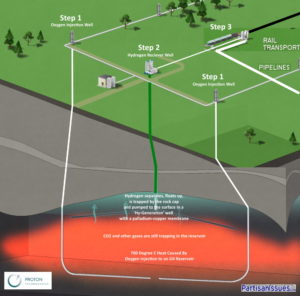 roducing Hydrogen with ZERO Emissions at 20% of the Cost?
roducing Hydrogen with ZERO Emissions at 20% of the Cost?
Keeping the process in the ground means there is no expensive carbon capture requirements. The process, shown to the right, produces Hydrogen at between 5% to 25% of splitting steam molecules above ground using the usual natural gas fueled process called Steam Methane Reforming.
The company simply injects oxygen and water/steam into existing, often abandoned, oil fields causing oxygen to mix with the hydrocarbons. That generates hot reactions, causing molecules to spit and hydrogen to float up. The hydrogen is separated from other molecules using a specialized membrane Proton calls a Hy-gengerator. The hydrogen is then easily piped to the surface using a collection well but all other chemicals, including CO2 stay safely, permanently, locked in the subsurface where it has been for millions of years.
Is Proton and This Technology For Real?
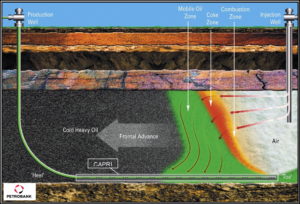 In 2011 Petrobank invested about $250 million into facilities at Kerrobert Saskatchewan to prove their oil extraction technology called Toe to Heal Air Injection (THAI).
In 2011 Petrobank invested about $250 million into facilities at Kerrobert Saskatchewan to prove their oil extraction technology called Toe to Heal Air Injection (THAI).
As you can see in the graphic to the right Petrobank was also injecting air into oil reservoirs but they were trying to extract oil.
THAI was supposed to compete with Steam-Assisted Gravity Drainage (SAGD) and while it did function as advertised, Petrobank was unable to prove it was better than SAGD.
When the Petrobank plant went to auction in the summer of 2017 Proton bought it. According Mr. Strem:
“…It’s a 6000 barrel per day oil facility but its been making some amount of hydrogen since it was turned on in 2011. It seemed like an ideal playground to try and obtain for this purpose.”
Petrobank apparently did not appreciate the hydrogen potential so they treated it as a waste gas and flared it off.
Is Anything Other Than Air Injected Into the Ground?
Today, Proton is injecting only good old Saskatchewan surface air into the reservoir. In the future, Proton will consider how water can help:
“… The reactions happen more efficiently at higher temperatures, so getting up toward the melting temperature of rock without exceeding it is the goal. If we just did straight oxygen injection, the temperatures would get too hot so adding water would do two things:
- mitigate the high end temperatures
- provide a significant supply of hydrogen
Water is precious commodity that the oil industry has had political and environmental issues with in the past so we asked Mr. Strem if Proton’s technology would have the same problems:
“…If (the reservoir) was a SAGD project, they have been injecting water into it for so many years that there is already alot of water down there. We are not currently injecting water/steam, but plan to soon.
We will be doing some steam injection to help mitigate the temperature but that is something that does not have to be a large volume. Its also not something that has to be fresh water. We could take raw sewage and put it in. So it can be waste water.”
Will Heating the Ground To Such High Temperatures Cause Problems?
In a word, no. Proton’s technology does not heat up the entire reservoir and will not cause unwanted effects like induced seismic.
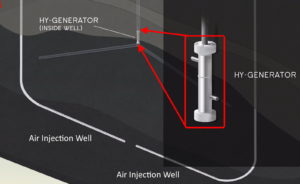 Does Proton’s Extraction Well Need Any Dangerous Chemicals or Materials?
Does Proton’s Extraction Well Need Any Dangerous Chemicals or Materials?
Proton uses what they call a “Hy-generator” at the base of the collection well to separate Hydrogen from other molecules. Today that unit is made with palladium which does not have any notable environmental impacts.
“…We have a membrane expert on the advisory board who is very familiar with many different types of membranes including ceramics. So we are going to be trying to optimize that both for cost and throughput of hydrogen.”
Does Proton Have Management Team That Can Drive This Technology to Market?
Proton is a small company that has only had a website since 2016. They have just 5 office workers and 9 field staff, so scaling potential is a legitimate question we can not definitively answer.
However, they have an advisory board of seven experienced energy professionals, including John Howard who was the Production Vice President at CNRL. Click HERE to see short bio’s on the entire team.
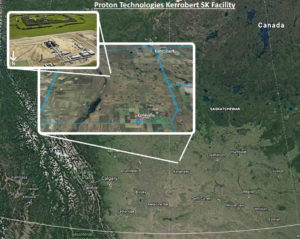 What New Infrastructure Will Be Required?
What New Infrastructure Will Be Required?
Their solution requires very little new infrastructure. According to Mr. Strem:
“…We would definitely rather start where there is existing infrastructure and wells, and seismic programs and all the people and information and roads. …Its a good idea to leverage the investments of someone else yesterday…”
We asked if this technology would help deal with the 90,000+ abandoned wells in Alberta:
“…Yes, absolutely (but) …the majority of those wells will still need to be abandoned. Especially if they are in shallow tight gas formations or have cracked casings…”
Mr. Strem believes that all new pipelines should be built with metallurgy capable of 100% H2, but pipelines today are usually limited to about 40% H2 before hydrogen embrittlement becomes a factor. A 15% limit of H2 in natural gas is because of higher flame temperatures in appliances. Hydrogen is already being added to natural gas supplies in Germany and UK.
“… I’m actually an advocate of having new pipelines be hydrogen capable. They don’t have to have all the valves in place (today) but as we transition towards a clean energy future, you might as well have that piece of infrastructure in the ground, which is a very small cost at the start.”
What Scale Is Required To Make This Economic?
We were quite surprised to hear Mr Strem inform us:
“…it’s already economic. We are making money but we would definitely like to scale up. We hope to build a (larger) demonstration plant between 20 and 50 tonnes of hydrogen per day.”
If The Technology is So Good, Why Hasn’t A SuperMajor Bought It?
PartisanIssues discussed the technology with several highly knowledgeable oil insiders before interviewing Mr. Strem. All of them said they thought the premise of oxygen injection, and a specialized recovery membrane should create something that easily extracts hydrogen. However, several of our insiders doubted Proton was ‘real’ because they thought an energy supermajor, like BP, Shell or even Suncor would have bought them up already, so we put the question to Mr. Strem:
“…We are fielding inquiries. …I don’t want to sell this business until it is scaled up enough and the cat is out of the bag so everyone knows you can leave the carbon in the ground. Its important for me. Seven million people per year die from air pollution and their is about seven billion of us. So there is a 1 in 1000 chance, every year, you could die from air pollution. I think that is a horrible and shocking statistic that needs to be fixed.
So what I want to do is build this out and let all these other oil companies have the opportunity to do it as well.
…If (oil companies see) something that has the perception of risk then they won’t get involved.
…Once we are making 50 tones a day at our demo facility, its alot easy to say, no you guys can go make 500 tones per day scaled up at your oil fields.”
Also, Proton has a letter intent with Cenovus.
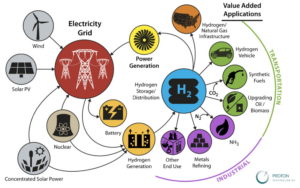 Can A Calgary Startup Really Reshape the Global Energy Business?
Can A Calgary Startup Really Reshape the Global Energy Business?
Because hydrogen can be economically and environmentally produced in massive quantities with Proton’s technology, it would appear that Proton Technologies stands the more than a chance of changing the global energy business.



0 Comments